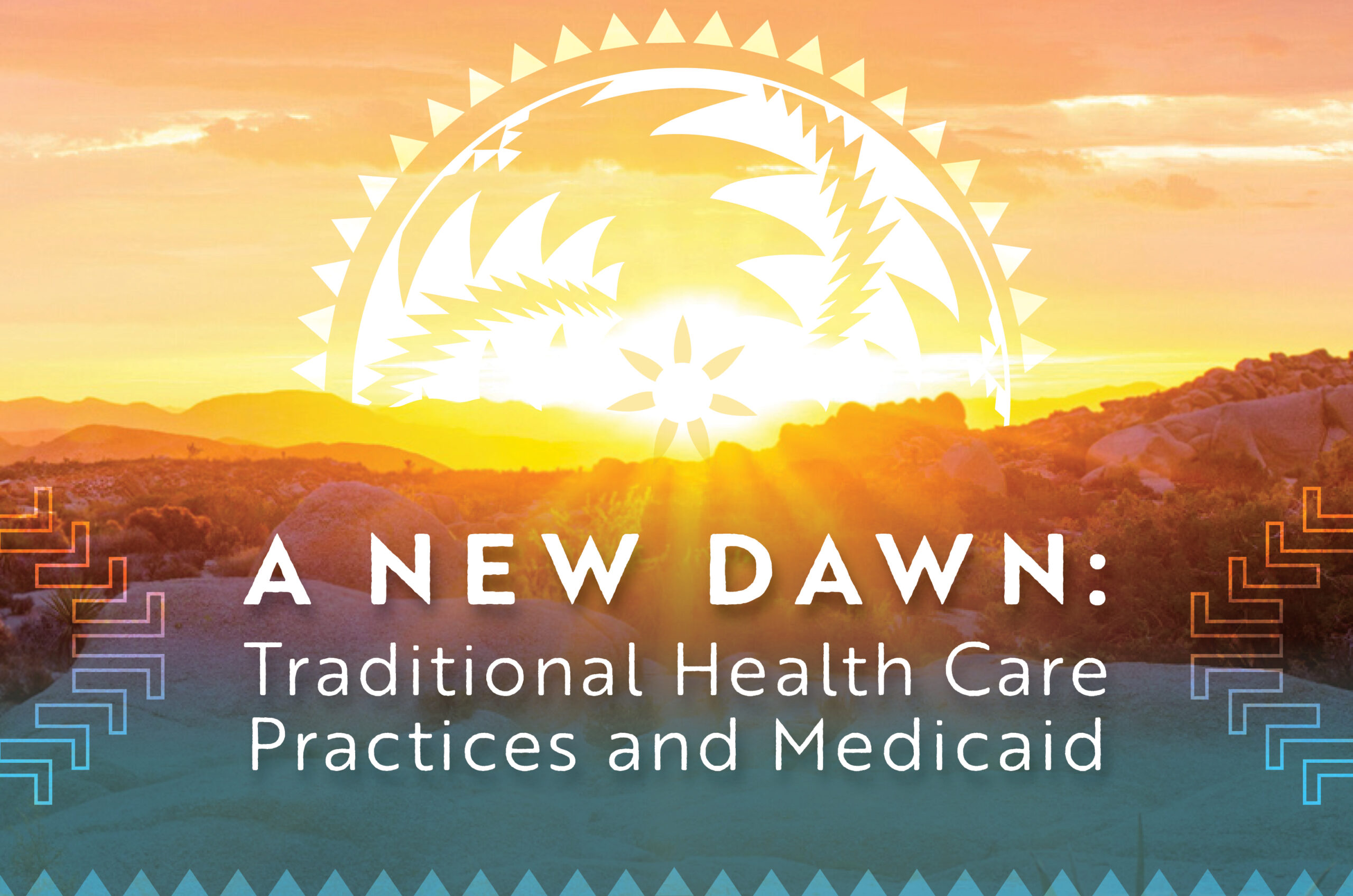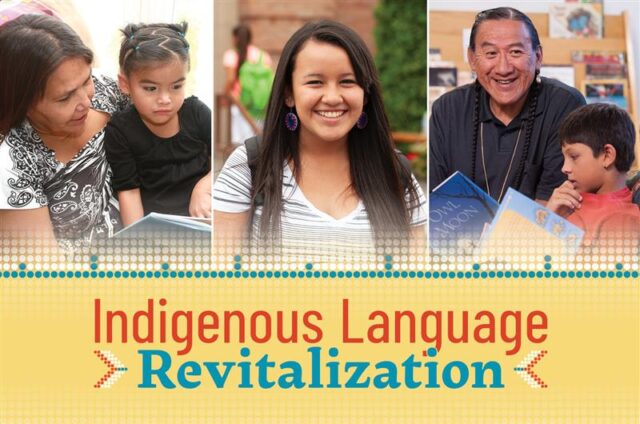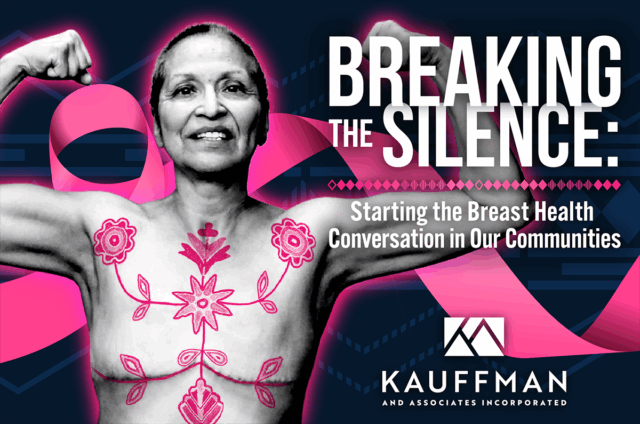By Josh Severns, LCSW, ACADC (Little Shell Chippewa)
Project Director, Traditional Health Care Practices Project (California), Kauffman and Associates, Inc.
Contributors: Art Martinez, PhD (Chumash) | Holly Echo-Hawk, MSc (Pawnee)
On October 16, 2024, the Centers for Medicare & Medicaid Services (CMS) approved an amendment to California’s Advancing and Innovating Medi-Cal (CalAIM) Section 1115 waiver, authorizing California’s Medicaid system (known as Medi-Cal) to reimburse traditional healing services delivered by Indian health care providers (IHCPs), tribal clinics, and urban Indian organizations through the Drug Medi-Cal Organized Delivery System (DMC-ODS).12 Less than six months later, the Department of Health Care Services (DHCS) translated that authority into practice with Behavioral Health Information Notice (BHIN) 25-007, issued March 21, 2025. In California, a BHIN issued by DHCS provides official notification to county and contractors of changes in policy or procedures at the federal or state levels. BHIN 25-007 spells out how IHCPs can opt in, document, and bill for traditional health care services.123 Under the notice, any Medi-Cal or CHIP beneficiary in a DMC-ODS county who meets Indian Health Service (IHS) eligibility can receive traditional healing just as they would receive evidence-based addiction treatment—whether the traditional healing encounter occurs in a clinic, a community setting, or via telehealth.3 IHCPs—including IHS facilities, tribally operated programs under the Indian Self-Determination and Education Assistance Act of 1975 (ISDEAA), and urban Indian organizations—may begin billing as soon as DHCS approves their streamlined “opt-in package,” which then allows retroactive claiming to the date of submission. Because every DMC-ODS designated county (40 in total, representing more than 96 percent of Medi-Cal enrollment) must honor these claims, traditional health ways are poised to reach scale in one of the world’s largest public insurance programs.1011 California’s detailed roadmap now stands alongside parallel approvals in Arizona, New Mexico, and Oregon, signaling a nationwide shift toward recognizing and respecting traditional healing within Medicaid.89
As the lead technical assistance provider, Kauffman and Associates, Inc. (KAI) is honored to support our partners at DHCS, the California Rural Indian Health Board (CRIHB), and the California Consortium for Urban Indian Health (CCUIH) in this project. We are committed to ensuring that the profound promise of this policy is fully realized, empowering providers to affirm with parity and respectfully weave these healing ways into the fabric of modern health care.
From Suppression to Sovereignty: A Century-Long Journey
Understanding the significance of these approved waiver amendments requires viewing their approval as a crucial milestone on a long, arduous journey from persecution to recognition. For nearly a century, the U.S. government’s official policy was not to integrate traditional healing, but to eradicate it. The Dawes Act of 1887 and the federal “Code of Indian Offenses” of 1883 explicitly outlawed Native religious ceremonies and the work of traditional healers, driving these life-sustaining practices underground.17 Practitioners were persecuted, imprisoned, and killed by U.S. government forces and newly arrived settlers. Generations were severed from cultural teachings through forced assimilation in federal boarding schools.19 It was not until the passage of the American Indian Religious Freedom Act of 1978 that these practices were finally decriminalized, marking a crucial first step toward not just protecting, but also actively sustaining our traditional ways.20
The path from outlawing traditional practices to funding them required the careful construction of a new legal framework for Indian health care. This began with the Snyder Act of 1921, which first authorized Congress to appropriate funds for AI/AN health.21 The Transfer Act of 1954 then moved this responsibility to the Public Health Service, creating IHS.21 The most recent and crucial legislative cornerstone is the Indian Health Care Improvement Act (IHCIA) of 1976, which, for the first time, authorized IHS and tribal facilities to bill third-party payers like Medicare and Medicaid.25 This hallmark policy was a game changer. IHS has been chronically underfunded by Congress since its inception, but the ability to bill Medicaid created a stable, ongoing revenue stream that now serves as a financial cornerstone for the entire Indian health system.15
The American Indian Religious Freedom Act of 1978 formally protects Native Americans’ ability to practice traditional ceremonies, as well as maintain access to sacred sites and ceremonial objects, such as eagle feathers. Culturally grounded providers within the Indian health delivery system (i.e., IHS, tribal, and urban Indian organizations) have long recognized the connection between traditional practices and health outcomes in Indian Country, even if third-party payers did not reimburse for such practices. This is where the power of the Section 1115 waiver becomes clear. These waivers allow states to test new, budget-neutral approaches to care.18 By funding traditional healing—a practice rooted in prevention and holistic wellness—California is making a cost-effective investment.20 Improving the long-term health status of Native people through culturally resonant care can reduce the reliance for high-cost emergency services and hospitalizations, aligning with Medicaid’s goal of providing better care at lower costs.22
Honoring Ancient Wisdom in Modern Care
The affirmation of traditional healing into Medi-Cal is a long-overdue acknowledgment of a system of healing that has sustained Native communities since time immemorial.25 A foundational principle is the inseparability of context, mind, body, and spirit, viewing health as a state of balance and harmony with one’s community and environment.26 This holistic worldview stands in contrast to the Western biomedical model, which often focuses on discrete pathologies.28
While traditional healing practices are diverse across the nation’s more than 500 tribal communities, many share common elements, such as the sweat lodge for purification, talking circles for communal support, and smudging with sacred medicines like sage and cedar.29 The value of these practices is not merely anecdotal and should not be relegated to the views of a Western evaluation paradigm; however, a growing body of public health research demonstrates their effectiveness, particularly for mental health and substance use disorders.15 These traditional practices are a direct and powerful response to the devastating impacts of historical and intergenerational trauma, which is a root cause of many health disparities in AI/AN communities.33 By funding these services, Medi-Cal is investing in a model of care that is not only evidence-based but also deeply affirming of cultural identity, which itself is a powerful pathway to resilience and well-being.35
A Collaborative Path Forward
Translating this monumental policy into practice requires navigating some administrative complexities. The waiver for California establishes two new practitioner types—traditional healers and natural helpers—who can be reimbursed for their services.36 Perhaps the most innovative aspect of California’s plan is its approach to credentialing. Rather than imposing a one-size-fits-all state mandate, DHCS empowers each participating IHCP to create its own process to identify and develop local qualification standards for healers.12 This affirms communities themselves are the only authorities capable of determining who is a legitimate healer and helper according to their own customs and community needs.38
The language and approaches used by the tribal-led partners of KAI, CRIHB, and CCUIH highlight a philosophical shift. The emphasis is on viewing traditional practices as complementary to, rather than integrated into, Western practices. This distinction is crucial. Often integration implies the absorption of a smaller element into a larger, dominant system—in this case, California is adding traditional practices as an equal and complementary service to the existing biomedical framework. This creates a new, stronger fabric from two distinct, co-equal, and respected threads. It implies co-existence and mutual reinforcement, not assimilation.39 As the lead technical assistance provider, KAI’s role is to bridge the gap between the waiver’s powerful intent and the on-the-ground capacity of IHCPs, by providing hands-on support to IHCPs as they navigate this transformative policy.49
Conclusion: A New Era for Tribal and Urban Indian Health
The approval to include traditional healing practices as a Medi-Cal health benefit under the CalAIM waiver is the result of early and persistent advocacy by CRIHB and CCUIH and a shared vision for a healthier future. It represents a powerful investment in our cultural ways, a sustainable funding stream for the Indian health system, and a crucial step toward healing historical trauma and rebuilding trust.42 The work, however, is just beginning. For these efforts to succeed, state agencies must remain flexible, IHCPs should embrace operational challenges with resilience, and the technical assistance partners must offer consistent, unwavering support. This is a moment to honor the wisdom of our elders who have carried these traditions through generations of adversity and to build a future where our next generations have access to healing that is both clinically effective and profoundly affirming of who they are.
Works cited
- California Department of Health Care Services. “CalAIM Traditional Health Care Practices Approval.” DHCS, October 2024, https://www.dhcs.ca.gov/provgovpart/Documents/CalAIM-Traditional-Health-Care-Practices-Approval.pdf
- Center for Health Care Strategies. “CMS-Approved Waivers Break New Ground for Medicaid Coverage of American Indian and Alaska Native Traditional Health Care Practices.” CHCS, 8 Jan. 2025, https://www.chcs.org/resource/cms-approved-waivers-break-new-ground-for-medicaid-coverage-of-american-indian-and-alaska-native-traditional-health-care-practices/
- California Department of Health Care Services. “Traditional Health Care Practices Benefit Implementation.” BHIN-25-007, DHCS, March. 2025, https://www.dhcs.ca.gov/Documents/BHIN-25-007-Traditional-Health-Care-Practices-Benefit-Implementation.pdf
- California Department of Health Care Services. “Stakeholder News: Traditional Health Care Practices Update.” DHCS, 21 Oct. 2024, https://www.dhcs.ca.gov/formsandpubs/publications/oc/Pages/102124-StakeholderNews.aspx.
- California Department of Health Care Services. “Traditional Health Care Practices.” DHCS, 2025, https://www.dhcs.ca.gov/Pages/Traditional-Health-Care-Practices.aspx.
- California Department of Health Care Services. “Traditional Health Care Practices Benefit Implementation – Enclosure 1.” DHCS, March. 2025, https://www.dhcs.ca.gov/Documents/BHIN-25-007-Traditional-Health-Care-Practices-Benefit-Implementation-Enclosure-1.pdf.
- California Department of Health Care Services. “Traditional Health Care Practices FAQs.” DHCS, 2025, https://www.dhcs.ca.gov/Documents/Traditional-Health-Care-Practices-FAQs.pdf.
- Kaiser Family Foundation. “Section 1115 Waiver Watch: Medicaid Services for Traditional American Indian and Alaska Native Health Care Practices.” KFF, Nov. 2024, https://www.kff.org/medicaid/issue-brief/section-1115-waiver-watch-medicaid-services-for-traditional-american-indian-and-alaska-native-health-care-practices/.
- CMS Approves Traditional Healing 1115 Demonstrations for Arizona, New Mexico, California, and Oregon – National Indian Health Board https://www.nihb.org/reports/cms-approves-traditional-healing-1115-demonstrations-for-arizona-new-mexico-california-and-oregon/
- California expands access to traditional healing for substance use … https://www.gov.ca.gov/2024/10/16/california-expands-access-to-traditional-healing-for-substance-use-treatment/
- October 16, 2024 Tyler Sadwith State Medicaid Director Department of Health Care Services Director’s Office P.O. Box 997413, M https://www.medicaid.gov/medicaid/section-1115-demonstrations/downloads/ca-calaim-dmnstrn-appvl-10162024.pdf
- Indian Health Care Delivery System- Kauffman and Associates Indian Health Care Delivery System – Kauffman and Associates
- About Us – Kauffman and Associates https://kauffmaninc.com/about-us/
- Religious Freedom for Native Americans | Friends Committee On … https://www.fcnl.org/updates/2016-09/religious-freedom-native-americans
- Reshaping the Journey: American Indians and Alaska Natives in … https://www.hopkinsmedicine.org/-/media/diversity/aamc-reshaping-the-journey.pdf
- 1978: American Indian freedom of religion legalized – Tribes – Native … https://www.nlm.nih.gov/nativevoices/timeline/545.html
- COUNCIL ON MEDICAL SERVICE – American Medical Association https://www.ama-assn.org/system/files/a24-cms03.pdf
- 1921: Congress funds American Indian health care – Tribes – Native Voices https://www.nlm.nih.gov/nativevoices/timeline/427.html
- 1954: President Eisenhower establishes the Indian Health Service – Tribes – Native Voices https://www.nlm.nih.gov/nativevoices/timeline/490.html
- 1976: President Ford signs Indian Health Care Improvement Act https://www.nlm.nih.gov/nativevoices/timeline/542.html
- Understanding the Indian Health Care Improvement Act (IHCIA) – Givers https://www.joingivers.com/learn/indian-health-care-improvement-act
- Section 1115 Waiver Watch: Medicaid Services for Traditional … – KFF https://www.kff.org/medicaid/issue-brief/section-1115-waiver-watch-medicaid-services-for-traditional-american-indian-and-alaska-native-health-care-practices/
- Strengthening Medicaid and Tribal Relationships to Better Support … https://www.chcs.org/strengthening-medicaid-and-tribal-relationships-to-better-support-native-populations/
- How federal funding cuts threaten tribal health services – PBS Wisconsin https://pbswisconsin.org/news-item/how-federal-spending-cuts-threaten-tribal-health-services/
- About Section 1115 Demonstrations – Medicaid https://www.medicaid.gov/medicaid/section-1115-demonstrations/about-section-1115-demonstrations
- Medicaid Section 1115 Waivers: The Basics – KFF https://www.kff.org/medicaid/issue-brief/medicaid-section-1115-waivers-the-basics/
- Efficacy of Traditional Healing … – NCUIH https://ncuih.org/wp-content/uploads/2021/06/The-Efficacy-of-American-Indian-and-Alaska-Native-Traditional-Healing-Methods.pdf
- Data Note: Medicaid’s Role in Providing Access to Preventive Care for Adults | KFF https://www.kff.org/medicaid/issue-brief/data-note-medicaids-role-in-providing-access-to-preventive-care-for-adults/
- Medicaid Expansion: Frequently Asked Questions | Center on Budget and Policy Priorities https://www.cbpp.org/research/health/medicaid-expansion-frequently-asked-questions-0
- The Impact of Personalized Preventive Care on Health Care Quality, Utilization, and Expenditures – PMC https://pmc.ncbi.nlm.nih.gov/articles/PMC5296930/
- Reduced Hospitalizations, Emergency Room Visits, and Costs Associated with a Web-Based Health Literacy, Aligned-Incentive Intervention: Mixed Methods Study – Journal of Medical Internet Research https://www.jmir.org/2019/10/e14772/
- Chapter 2: American Indian and Alaska Native Healing https://www.cancer.org/content/dam/cancer-org/microsites/circle-of-life/documents/module9-american-indian-alaska-native-healing.pdf
- Native American health: traditional healing and culturally competent health care internet resources – PubMed https://pubmed.ncbi.nlm.nih.gov/16893848/
- (PDF) Native American Healing Traditions – ResearchGate https://www.researchgate.net/publication/240532277_Native_American_Healing_Traditions
- Traditional Health Care Practices Implementation https://www.ihs.gov/california/index.cfm/tribal-consultation/resources/presentations/2025-tls/wednesday/traditional-health/
- From History to Healing: A Guide for Nurses Caring for Native Americans – AACN https://www.aacn.org/blog/from-history-to-healing-a-guide-for-nurses-caring-for-native-americans
- Traditional Healing – Native American Connections https://www.nativeconnections.org/addiction-treatment/traditional-healing/
- Four Sacred Medicines | American Indian Health Service of Chicago, Inc. https://aihschgo.org/four-sacred-medicines/
- Indigenous patients may not trust you. Know how to break though. https://www.ama-assn.org/delivering-care/population-care/indigenous-patients-may-not-trust-you-know-how-break-though
- An Introduction to Traditional Healing in American Indian and Alaska Native Communities https://pmc.ncbi.nlm.nih.gov/articles/PMC11885593/
- Incorporating Traditional Healing Into an Urban American Indian Health Organization: A Case Study of Community Member Perspectives https://pmc.ncbi.nlm.nih.gov/articles/PMC3621761/
- October 21, 2024 – Stakeholder Update – DHCS – CA.gov https://www.dhcs.ca.gov/formsandpubs/publications/oc/Pages/102124-StakeholderNews.aspx
- Traditional Health Care Practices Benefit Implementation BHIN – DHCS – CA.gov https://www.dhcs.ca.gov/provgovpart/Documents/Traditional-Health-Care-Practices-Benefit-Implementation-BHIN.pdf
- The Indian Health Service and Traditional Indian Medicine – AMA Journal of Ethics https://journalofethics.ama-assn.org/article/indian-health-service-and-traditional-indian-medicine/2009-10
- About Us – California Rural Indian Health Board https://crihb.org/about/
- About | CCUIH https://ccuih.org/about/
- Training & Technical Assistance – Kauffman and Associates https://kauffmaninc.com/service/training-technical-assistance/
- CalAIM Traditional Health Care Practices Approval – DHCS – CA.gov https://www.dhcs.ca.gov/provgovpart/Documents/CalAIM-Traditional-Health-Care-Practices-Approval.pdf
- Traditional healing practices and their role in modern healthcare | https://library.fiveable.me/hs-native-american-studies/unit-15/traditional-healing-practices-role-modern-healthcare/study-guide/oO9vrzL55ArR4Lk2



